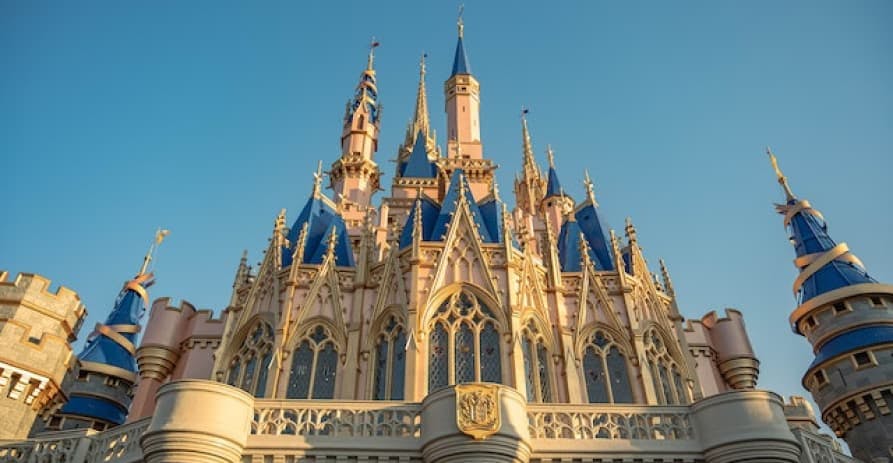ESG / CSR
Industries
Could Theme Parks Become Sustainable?



Six Flags, Disney World, and more – a theme park may no longer be the first vacation destination on everyone’s mind these days, but they most certainly haven’t gone out of style: with around 58 million people visiting Disney World every year.
In addition to this, a theme park like Disney World remains one of the most visited places amongst Americans – with a whopping 37% of U.S. citizens saying they’ve been to the theme park at least once.
However, theme parks are indeed losing their momentum – with last year’s Fourth of July weekend at Disney World proving to be one of the worst turnouts in a decade for the infamous park.
Perhaps it's the over stimulation, rising ticket prices, or concerns regarding sustainability that these parks are now facing – is there a way to turn them around so these theme parks can appeal to the public once more?
In this article, we’ll discuss why a theme park may not be sustainable, their carbon footprint, how sustainability impacts tourism, and how a theme park could become sustainable.
What is a theme park?
A theme park is a place filled with entertainment, often niche in its experiences such as at Disney World or Universal's Wizarding World of Harry Potter, which can offer a wide variety of activities.
Theme parks will usually offer various attractions such as:
- Roller Coasters
- Interactive or Intellectual Games
- Carnival Games
- Immersive Experiences or Simulations
- Live Performances
- Water Wides
- Themed Restaurants
- Souvenir Shops
👉 A theme park usually offers something for everyone to enjoy, making it a great choice for family vacations or large group hang-outs.

What is the carbon footprint of a theme park?
In the midst of all the magical fun that a theme park may have to offer, many may not realise that all of those rides, lights, and unlimited turkey-legs take up an exhausting amount of energy – and leaves behind a massive carbon footprint.
The best way to understand the carbon footprint of a theme park is to use Disney World in Orlando, Florida and DisneyLand in Anaheim, California as examples for just how emissive theme parks can be.
Here are some of the ways a theme park like Disney World can create an exceptionally high carbon footprint:
- Tourists Driving to the Theme Park – Disney World is estimated to be responsible for the emissions produced by over 3 million vehicles driving to Disney World each year alone, and the fact many tourists will opt to take a road trip to Disney World doesn’t help with the scope 3 emissions associated with the theme park. In fact, Disney World related buses had an average of 4.6 million passengers every month.
- Excessive Waste with Food & Plastic Consumption – As over 10 million hamburgers, 6 million hot dogs, and 1.6 million turkey drumsticks – a theme park like Disney World is meat-heavy which could create an excess carbon footprint. In addition to this, around 13 million bottles of water and 75 million Coca-Colas are sold every year at Disney World – and with all of the walking around a theme park like this, many people are bound to throw away their empty bottle instead of waiting for a recycling bin.
- Massive Amounts of Electricity Required – All of those rides require an exorbitant amount of electricity to run. The more people on the ride, the heavier the ride – and the more power necessary to run the rides. In fact, it is estimated that Disney theme parks pay an annual electric bill of $10 billion and use over a billion kilowatts of energy to power their rides every year. This is in addition to the $7,424 necessary per day to keep all of the roller coasters in the theme park running.
- Firework Shows – In addition to the rides at Disney World, the attraction park also holds numerous light and firework shows, sometimes daily depending on the season – which can also be held accountable as the reason for excessive emissions.
- Merchandise & Consumerism – Lastly, Disney World is subject to excessive plastic consumption – with all of the merchandise for sale in the numerous gift shops across the park, portable food for sale, and the costumes made for all of the characters.
👉 Ultimately, a theme park can easily find itself subject to excess emissions from the electricity used for rides, excess consumption of food and merchandise, and the emissions created via transportation.

If a theme park isn’t sustainable, does it impact tourism?
Around 10 to 15 years ago, sustainability probably wasn’t on the forefront of people’s minds when taking their kids to Disney World for the day – but younger parents, millennials, and Gen Z are more cognizant of the potential downsides of a theme park than ever before. This could deter people from traveling to a theme park or staying at their associated hotels.
Think about it – the nature of young families and their values are changing. If a young family has a vegan child – concerns may arise on what they will eat all day if there are no plant-based options available. In addition to this, some families are becoming more aware of greenwashing in hotels, and may not stay at the accommodation provided by the theme park if they prove guilty of this deceitful marketing tactic. Animals lovers may wonder how animals in a theme park are being treated, such as at the safari offered at Disney World.
Overall, there are many facets of sustainability within a theme park that could deter people from wanting to visit – and making a theme park more sustainable is bound to help theme parks bounce back from their current slump. This is because theme parks which comply with sustainability will be able to adhere to environmental regulations, enhance brand reputation, and even reduce their operational costs – all of which are likely to appeal to future theme-park-goers.
👉 While sustainability may impact the future of tourism and a theme park, the most likely solution for the dramatic dip in theme park visits is recent inflation and rising ticket prices.

How could theme parks become sustainable?
Theme parks could absolutely make an effort to become sustainable, but this often means needing to allocate time, money, and resources to get a sustainable theme park off the ground. On the other, a theme park will always result in the need for electricity consumption and incoming traffic from greenhouse gas emitting vehicles – so it is hard to determine if a theme park could every be deemed truly sustainable.
Here are just a few ways that theme parks could reduce their emissions and become more sustainable:
- Close/Open Parks Earlier or Later – One idea is to open the parks just a little later and close them a little earlier every day. Even running the amusement park an hour less every day could help a theme park cut back on their carbon emissions. Also, certain theme park lights can be turned off early to help save on electricity and energy consumption.
- Use Renewable Energy to Power Parks – Disney World located in Orlando is the epitome of a renewable energy powerhouse, with copious amounts of empty, rural land surrounding the theme park – which could be used to install solar panels. This renewable energy could then be used to power energy-intensive rides and would make a huge difference over time in the electricity consumption and carbon footprint of their theme park.
- Reduce Single-Use Plastics – Food in a theme park is often eaten on the go, and people aren’t likely to carry their containers until they see a recycling bin. Therefore, theme parks should make the effort to serve snacks and meals in compostable containers or set up more recycling bins in their theme park.
- Seek to Alter the Design of Rides – New rides are built in a massive theme park all of the time, but theme parks looking to become sustainable should make a larger effort to understand the suppliers used and LCA of their future ride or tourist attraction. This is because the materials used to build the ride itself may be creating a carbon footprint, meaning this could encourage the development and construction of more sustainable parks and rides in the future.
💡 Some theme parks, such as Disney, are committed to becoming more sustainable in the long-run by setting several, ambitious environmental goals – such as being determined to not contribute to any landfill, switch to all recyclable materials in their food services and packaging, and to serve ethically and environmentally friendly seafood at their parks and cruise ships.
However, on the flip side – it could prove exceptionally difficult for theme parks to become sustainable. This is because these sustainable initiatives cannot be implemented overnight, meaning that mindfulness will be required every day amongst employees at theme parks, roller coaster designers and developers, and the transportation department associated with the theme park.
In addition to this, a theme park looking to become more sustainable will often need to acquire the necessary start-up costs – such as to implement renewable energy, or even install more water fountains or recycling bins across the theme park.
👉 Ultimately, a theme park could become sustainable – but consistent effort would be necessary if a theme park wants to go green for the long-term.

What can you do to make your trip to a theme park more sustainable?
If your favorite theme park isn’t able to make the changes you want them to, it’s possible for you to take action into your own hands and make your own trip to a theme park more sustainable.
Here are some ways you could make your trip to your favorite theme park more sustainable:
- Use Public Transport Instead of Driving – a massive contributor to excess emissions from a theme park comes from the travel most theme-park-goers commit to in order to arrive at the theme park in the first place. For example, Disney World in Paris attracts visitors from all over Europe – where some European families may even take a roadtrip to reach their destination. One solution to this would be to opt for Europe’s excellent rail system in place of driving to reduce their carbon footprint.
- Go Paperless – One thing you could do to reduce your footprint is to go paperless in the park. In this day and age, there is no reason to carry around a paper map or print out your tickets when all of that can be done on your smartphone.
- Food Choices – Some of the most infamous theme park snacks, such as the turkey leg at Disney World, can create a massive carbon footprint. Therefore, one of the best things you can do when visiting a theme park is opt for vegan and vegetarian options when you can.
- Avoid Littering & Recycle – Don’t leave trash or foods for animals, and when possible – try to eat sitting down so that you are near trash and recycling bins. If you must take your food with you on the go while out and about in the park, it’s pivotal to properly recycle your trash after you finish eating – because if you fail to properly recycle your plastic cup, it could end up in the landfill and emit superfluous emissions.
💡Insider tip: try to bring your own reusable water bottles to a theme park – as many theme parks now offer water filling stations. This way, you will reduce your plastic consumption and ultimately mitigate even more greenhouse gas emissions.
Overall, theme parks could indeed become sustainable – but it would require time, money, and effort for a theme park to make its operations less emissive intensive. Theme-park goers can aid in this transition, but ultimately – it is the theme park itself which must lead the way to “greener” roller coaster rides.
What About Greenly?
If reading this article on how theme parks could become sustainable has made you interested in reducing your carbon emissions to further fight against climate change – Greenly can help you!
At Greenly we can help you to assess your company’s carbon footprint, and then give you the tools you need to cut down on emissions. We offer a free demo for you to better understand our platform and all that it has to offer – including assistance with boosting supplier engagement, personalised assistance, and new ways to involve your employees.
Click here to learn more about Greenly and how we can help you reduce your carbon footprint.




